Oh. My. Cabbages. We are back guys!
The Legend of Korra (LoK) fandom has returned with a vengeance, thanks to the new Dark Horse comic, Turf Wars. This is meant to serve as a direct continuation from the final shot of the beloved Y7 cartoon that ended in 2014, and we mean that literally. Like…so literally.
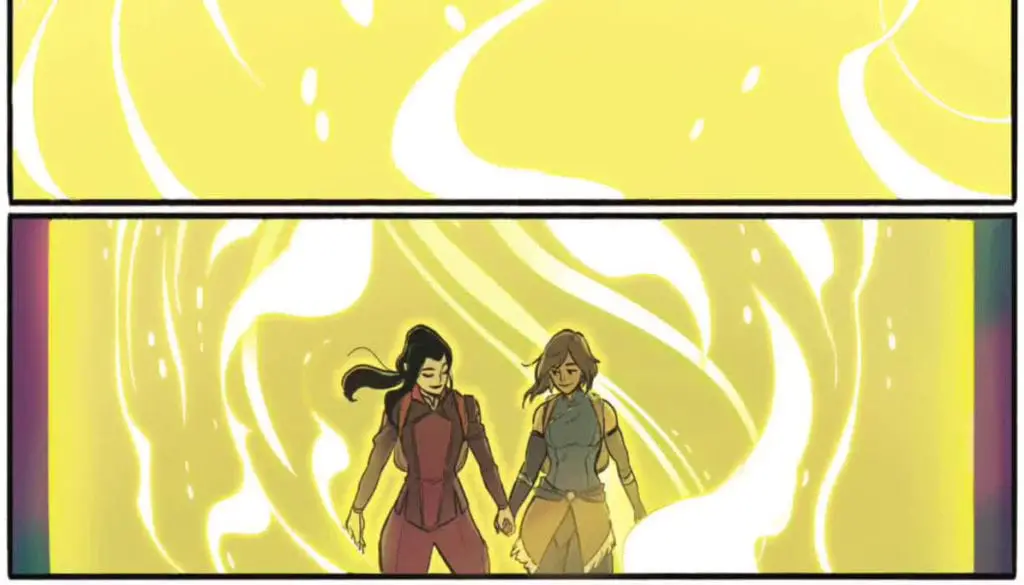
Given that LoK ended on such a positive and affirming note—the titular protagonist riding off into the sunset with her new girlfriend (and best friend in general), Asami Sato—there was much anticipation for how this wlw relationship would be explored. In many ways, the popularity of “Korrasami” set quite the high bar for these comics to meet. Before we (Griffin and Kylie) discuss whether or not we feel these expectations were met and/or exceeded, let’s take a high-level look at what happened.
As a warning, this article contains full spoilers for Turf Wars Part 1.
“Can you interpret that?”
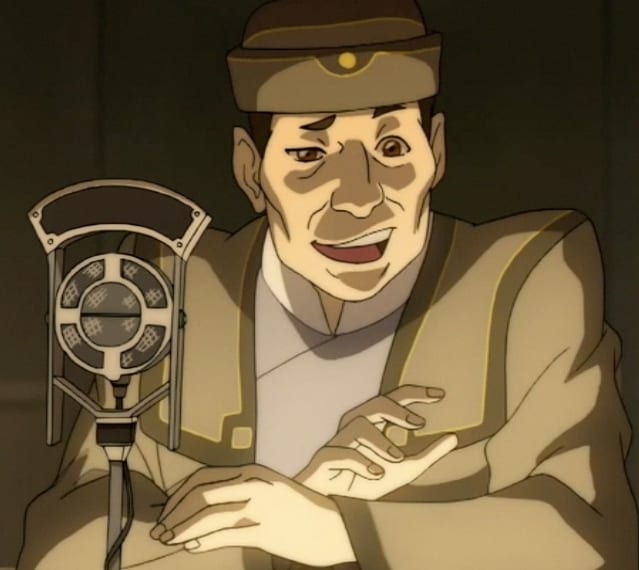
(Transcript): This time, in the licensed comic adaptation Turf Wars (brought to you by Varrick Industries International. If it ain’t broke, it’s Varrick!)…
Korra and Asami arrive in the spirit world and frolic for days in a fluffy montage involving dragonbirds, swimming, rock climbing, and also starvation! They share a kiss and express how much this relationship means to one another. In a stroke of genius, Korra then takes Asami to the Southern Water Tribe to announce the happy news to her parents. Tonraq and Senna are overjoyed (though surprised), though Tonraq cautions Korra that not everyone might be accepting, and she should keep this to herself.
Korra storms out, but on their way back to Republic City, Asami mentions that while Tonraq is being overly-cautious, he’s not totally off the mark. They warp to the heart of the city, where horrors! There’s already a conflict! It seems that the airbenders are squatting in land owned by a developer, but he’s a big doo-doo head who screwed over Hiroshi eight years prior. He wants to build an amusement park in the Spirit World. Asami and Korra are NOT on board, so Korra pops into the Avatar state and terrifies him and his contractors, causing them to run away for fear of their lives. All the airbenders think this is nifty!
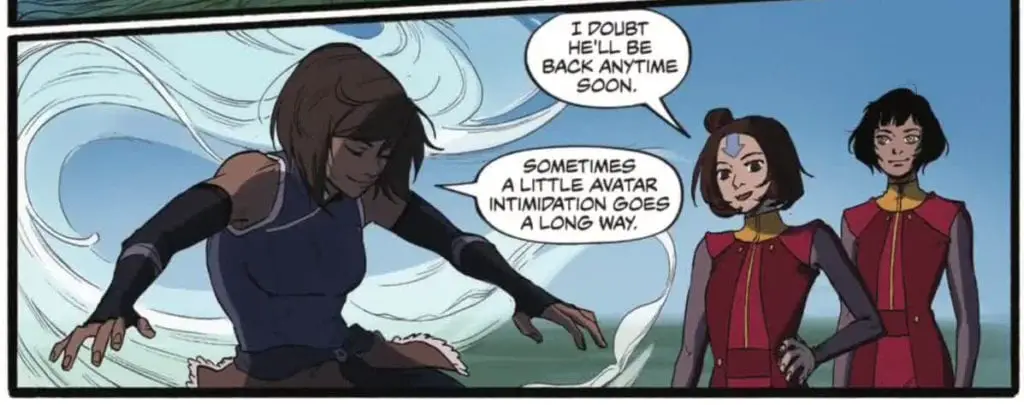
It’s suddenly nighttime! And there’s a turf wars fight…somewhere in the city. We’re not sure where, since everyone is evacuated, but that’s not important right now. What *is* important is that we have a new villain: Tokuga. He uses hook-swords, smoke grenades, daggers, and chi-blocking to achieve his ends! Finally, a non-bender antagonist (who actually IS one this time)!
The fabulous bending brothers, now partners in crime-busting, arrive on the scene to break up the fight and nab Two-Toed Ping and Mushi. Lin fruitlessly interrogates Ping, until Mako suggests a clever ruse that outs all the exposition we need. It seems Tokuga is certifiably Bad™: in just under three weeks, he has taken control of almost every triad and staked out his turf in a part of the city that remains to be determined. Quite the impressive feat from this newcomer! Someone should probably stop him!
Meanwhile, it’s day again! Korra and Asami hit up the Evacuee Camp and find an undisclosed (but massive) amount of people who have been displaced by Kuvira’s invasion. Raiko is busy hiding in the city, preparing for his unopposed re-election campaign, so all the duties have fallen to Zhu Li, for reasons that remain to be explained. Asami realizes that no one has drawn plans for new housing developments—literally the only thing anyone needs right now—and gets to work, while Korra gives a rousing speech to the crowd. It’s wonderful to see the Avatar back in their good graces (for once).
Korra, Asami, and their new best friend Zhu Li head to Raiko’s campaign office to show him the plans Asami drew. He says the city has no money, but when Asami and Zhu Li offer Future Industries and Varrick Industries International to foot the bill, he agrees to let Asami fix his city. Again! However, he will not do anything about the lawful landowner building on his lawfully owned land by the spirit portal, to the frustration of Korra. Boo these protections for the private sector!
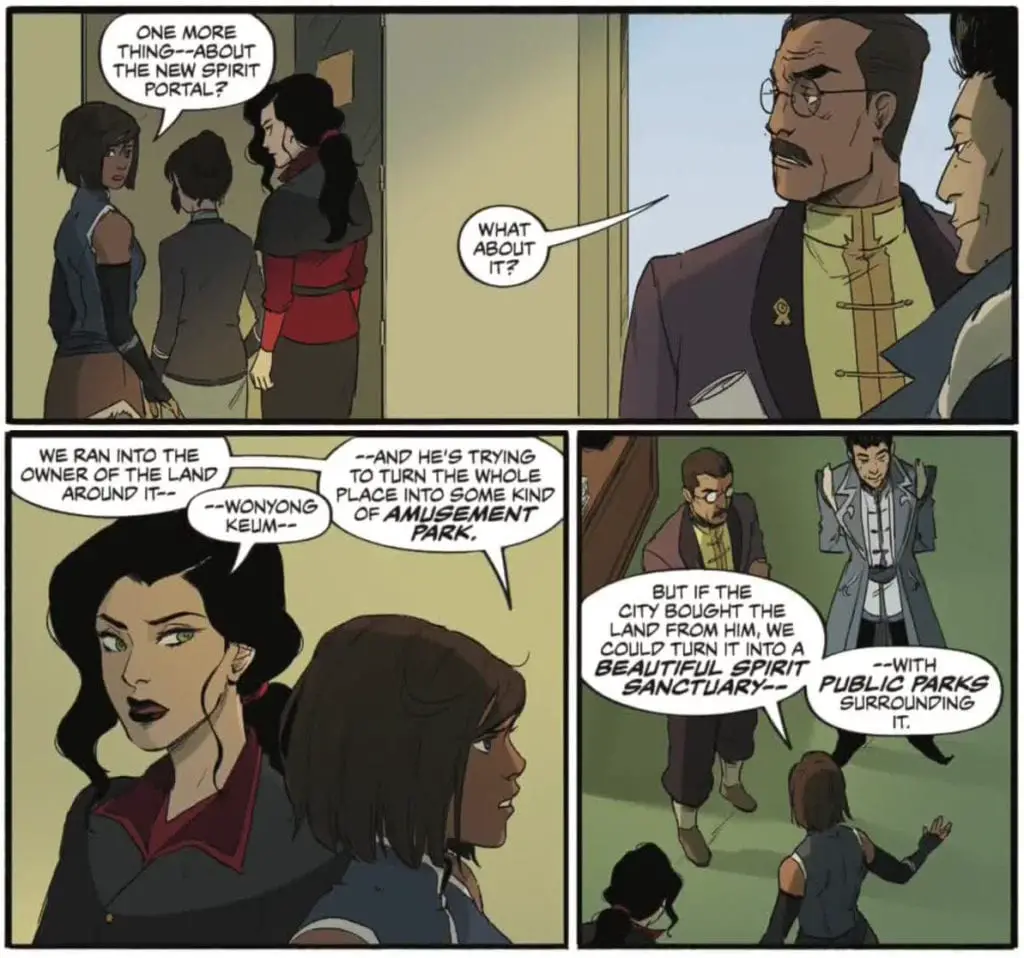
One costume change later, Korra and Asami find themselves on Air Temple Island, where Kya pops up and compliments their relationship. She has had girlfriends, so she knows everything about everything, and info-dumps on the treatment of gay couples for the entire history of the world. As it turns out, the Fire Nation and Earth Kingdom were quite unaccepting (and possibly still are), where the Water Tribe just doesn’t want to hear about it, and the Air Nation were totally a-okay free-love advocates. Asami notes that (specifically) Republic City is mostly accepting now, though the confusingly-closeted Kya advises Korra and Asami to “tell their own story” because they’ll “know” when the time is right. Unlike her, we suppose.
Don’t reflect on that too long, folks, because there’s an action scene! In his frustration over Korra physically threatening him, the lawful land developer turns to…not the police, but TRIADS in a shocking development, to help rid the area around the spirit portal from the still-squatting airbenders. Jinora warns the Krew of this, and our four heroes set off to save the day. There’s a thrilling action sequence including lavabending, smoke grenades, Mako getting taken down by his sling, and Asami getting her hair wet. It’s all very exciting, but when Korra turns her attention to save Asami’s Pantene from washing out, the spirits attack, and one turns Tokuga into a half-spirit monstrosity! Better luck next time! Then Korra and Asami jam their tongues down each other’s throats in front of their friends. That’s *one* way to tell your story!
Everyone is accepting, even Mako who just needs an (understandable) minute, but there is still danger lurking for our favorites. You see, the evil, now-corrupted Tokuga has taken control of the land developer’s business. What will Korra and Asami do next? Find out on January 31, 2018!
“Only three years!”
Overall, this was pretty straight-forward in terms of plot. You can likely tell that we have a few questions about the main narrative, mostly relating to the evacuee situation, but that is a piece for another day. We should probably go right ahead and dive into the discussion of the most hotly anticipated element of this comic: Korrasami, the portrayal of their relationship, and their specific plotline.
We’ll come right out and say it—we’re not particularly pleased. We’re upset, quite frankly, and even insulted. But before we explain our feelings, we do think it’s important to back up and recognize that this is almost certainly a validating comic for a lot of people.
It might not have been what we wanted, nor did we find it personally validating given our own intersections and experiences, but there is no denying how refreshing it is to see queer topics discussed so openly and unabashedly, especially in a book meant for younger readers. A good ol’ story about how to navigate coming out? If there had been more of this stuff when we were younger, maybe it wouldn’t have taken us both until mid-college to figure out that we’re bisexual. And while navigating that realization wasn’t dramatic for us, we recognize that there are people in far less accepting situations than our own, and if this comic can help validate their experiences or give any courage/comfort, then we are nothing less than thrilled.
Let’s not forget that Korrasami’s existence in 2014 actually helped a lot of kids find the language to come out to friends and family, and sometimes even contextualize their own feelings. Media is not created or consumed in a cultural vacuum, and this is just one reason why stories matter. We could see Mike’s intent to do this subject justice and provide as positive a takeaway as possible.
The thing is, while we can recognize these benefits, and certainly see the intent and conscientious approach, we personally didn’t find the execution compelling, validating, or even uplifting. At best, we could view the handling of the subject matter as an After School Special, something we had actually expressed our concern about, but even After School Specials rarely dip into territory with implications as negative as the ones we found.
We know that these implications might not be immediately obvious to everyone, or even relevant against the larger story. We both have very specific backgrounds and experiences, and also full disclosure: we’ve spent *a lot* of time thinking about this comic. Overthinking, if we’re being honest with ourselves. Similarly, the depiction of bisexual couples in media is something of interest to us, a bisexual couple, and for that reason we have our own unique thoughts about approaches to portrayal. So for anyone who read and loved this, or felt uplifted: we’re not here to take anything away from you. We’re just providing our review.
“Everything you do is allegedly!“
In our opinion, the biggest misstep was introducing a very contemporary portrayal of institutionalized homophobia (and by extension institutionalized sexism) where none had been present prior, and where it doesn’t quite make sense. We know we made the case for this already. But we do stand adamant that homophobia to the degree that Korra would have to second-guess living honestly does not fit with the setting of the Avatar-verse.
We feel as though our argument lends itself to strawmanning, and to be clear, we’re not saying there’s no sexism in the universe, or homophobia that results. We’re saying that to have it on a systemic level to the point that Korra would even be thinking twice about publicly dating Asami clashes with the agency we’ve seen our female characters granted since the very beginning of Avatar: The Last Airbender.
We don’t expect you just to take our word at face-value (we sure wouldn’t), and for that reason, we’ve written a cool 10,000 words, complete with academic sourcing (we’re professionals!), which picks apart exactly why this portrayal makes no sense, down to the smaller details like the cultural dynamics that Kya described. Yes, we understand how frustrating it is to just be asked to accept that we have a great argument that backs this up, but we don’t want you here all day. That is going to be a separate piece we release on Friday, so please stay tuned, because we’re quite proud of the work we did in it. We also do think this topic is very important and needs to be discussed openly and in full, especially once everyone’s had the time to read and for their own opinions.
To dip into the details just a bit, we will say we had enormous discomfort with the evoking of gestapo-imagery to describe the toxic homophobia present in the Fire Nation after Sozin took power. There’s a lot of reasons this doesn’t work, not the least of which being that the Fire Nation is canonically the most egalitarian. But as two jews reading the comic, we found it infuriating that such imagery would be called upon simply to remind us that homophobia is bad.
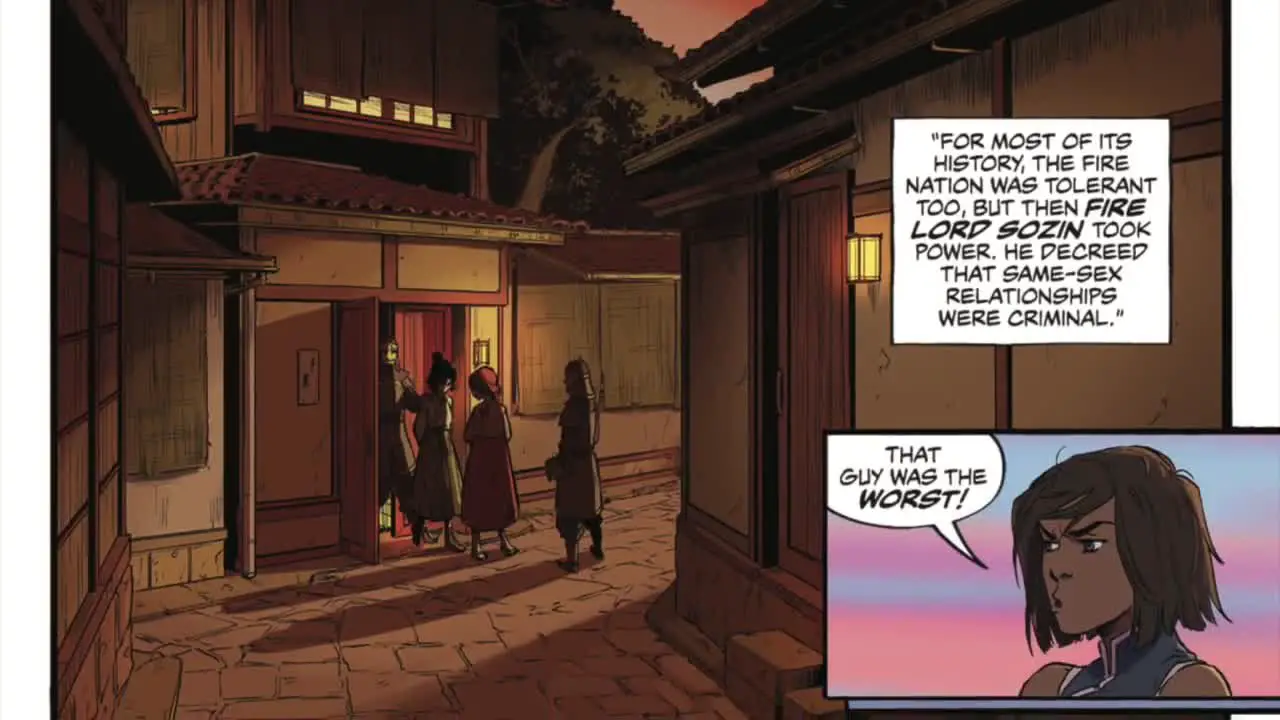
We also have a discomfort with how the Eastern philosophies and cultures that Bryan and Mike had formerly been inspired by for their world-building were completely dismissed in favor of very Western concepts of homophobia—specifically portrayals based in contemporary Christianity.
And, okay, we have to point this out: with the way everything is described, the Avatar-verse is worse than ours with regards to the treatment of queer relationships. We know that sounds crazy, but just take a second to realize that Kya admitted to still being closeted. Only her friends and family know:
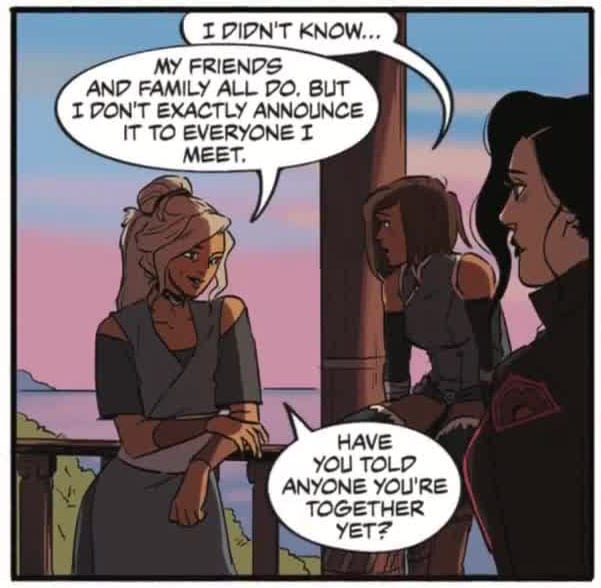
Even in the most homophobic countries, celebrities are able to live openly. Kya, the daughter of Aang and Katara, having to hide who she is? It’s absolutely absurd. And comes with the implication that two of our favorite protagonists from ATLA completely dropped the ball and allowed their daughter to live such a repressive life.
Frankly, it’s depressing to think about, just like the message that a 230-year-old demigod who served as the world’s spiritual leader was “unable to find acceptance” in her lifetime. We are really, really sick of media telling us that as queer individuals, we’re doomed to be piled on and treated as social pariahs. We get this enough from our jewishness, we promise. Maybe it’s unfair that we would have preferred the Avatar-verse to be more escapist in nature, but we truly don’t find it more progressive, or even narratively interesting, that such virulent homophobia was shoehorned in.
What really grinds our gears is that this same exact story with the same message (live openly and be happy) could have been told in such a way as to not pile on, and not counter-canon with very minimal changes. In fact, the only thing that would need to change is the lettering of the already-completed book. 10 minutes of work tops, really. (Oh, and chuck the Sozin page in the recycling bin on the way out, please.)
Because, see, Asami and Korra could have still had to grapple with whether or not to make their relationship publicly known. Asami is the owner of what is essentially a fusion of Lockheed Martin and Ford Motors, and Korra is the world’s spiritual leader. There could be tricky political situations to navigate, and sacrificing their privacy might not be appealing. Think about Asami drawing the plans: Korra supports them, but would there be accusations of a conflict of interest? Probably with the Republic City press corps, who are still so sensationalist that they’re able to find poll numbers where an unopposed candidate is at -3%.
Our point is, their inherent situation almost lends itself to the perfect allegory for what we assume is going to end up being an “out and proud” conclusion, and it would come without the reminder that queer couples will always face a lot of crap, as well as all the drastic inconsistencies with the former world-building. We fail see how such a story would be any less validating to LGBT+ fans. Just because it wouldn’t include anachronistic words like “orientation” and “coming out” doesn’t mean it’s not a story that would resonate. And heck, it might be able to put the concept into language that straight readers find more accessible, too. A teachable moment!
Truthfully, the Avatar audience has always been smart. We didn’t need Aang talking about how bad the “death penalty” is to understand his decision in the finale of ATLA. And maybe more to the point, we didn’t ONCE need Korra and Asami discussing how special their romantic attachment was to one another to understand where the final scene in LoK came from. It was clear what was happening between them (even to younger viewers), and part of the reason it was so affecting was its complete lack of ceremony.
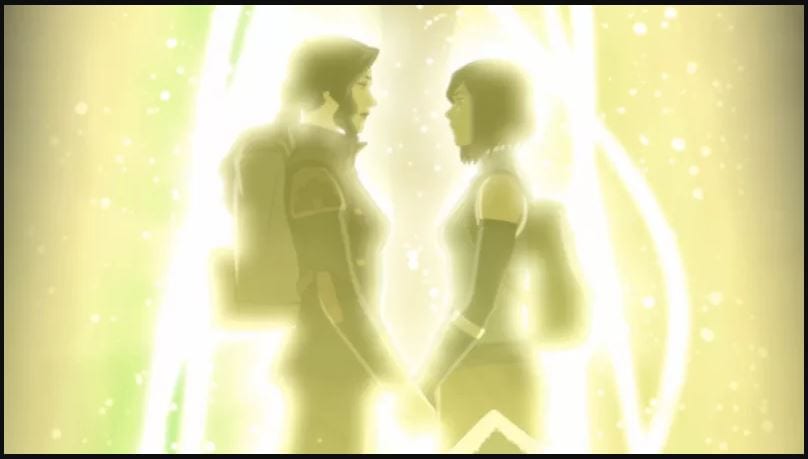
This was just…unimaginative. Homophobia does not need to be the default culture, and two queer women can have storylines beyond fighting for their right to exist. Yes, we’ll happily take this over the slew of dead wlw characters on our TV screens, but we’re just tired and frustrated that this is the go-to, which is not without its own issues. If we can only imagine settings with entrenched homophobia in our speculative fiction, how do we move on?
“It means that when you base your expectations only on what you see, you blind yourself to the possibilities of a new reality.”
And we’re sorry, but we view this choice as pandering, heavy-handed, and infantilizing. We recognize opinions on this will differ, and we’re certainly not coming from a place where we dislike seeing Korra and Asami’s relationship made explicit. We just don’t feel that we needed a plotline about how homophobia is bad. We also certainly don’t need to see Korra and Asami battling such a strawman, especially when the shows never dipped into something so forced. We’re sure they’ll end up triumphing…whatever that looks like (I guess effecting the change that Kyoshi somehow never managed). But the shoehorning in of this conflict in the first place makes any victory completely hollow.
“He’s definitely…something.”
The main plotline itself was…fine. We actually have a rather amusing theory for why anything that’s happening is happening, which we’ll write in a piece at a later time. (Varrick’s behind it all!)
That said, there were quite a number of leaps we had to make in our mind, like accepting Tokuga’s magically speedy takeover of the triads, the formerly unusable spirit wilds land now having an owner, evacuees in dire conditions getting supplies from Ba Sing Se of all places while most of the city looked perfectly fine to us (and the destruction had only seemed to be relegated to one district, primarily), the airbenders squatting, Zhu Li being in charge while Varrick was nowhere to be seen (or was he??), and even Kya being there at all just to provide an info-dump of information Korra and Asami should have known from a basic history class.
We do have to express some chagrin at Korra’s characterization: she seemed to be back in that punch-first Book 1 state, and seeing her so blasé about using the Avatar State to intimidate someone with papers showing his lawful ownership of land was distressing. We could see her saying “What are you going to do about it?” and just standing there, but the whole point of her healing arc was that she had found inner peace and balance, and was much more contemplative about how she’d proceed in a conflict.
Don’t get us wrong: this is still the lady who hurled herself in front of a giant death ray without a second-thought. But that was to protect someone—an antagonist at that—and not scare the pants off of poor construction workers. Likewise, her immediate anger at her father for pointing out something in a very reasonable way reminded us of Book 2.
We did like Toguka’s character design, and are thrilled there’s a nonbender antagonist (especially since they kept with the tradition of ending the “first episode” of each book on a shot of the antagonist). If we had our absolute druthers: there’d be a female land developer to serve as a Kuvira-esque foil for Asami. We know that’s not a reasonable expectation to place on these comics though, and in fairness, nothing delighted us more than Asami “the angry one” Sato yelling at the guy for trying to evoke her father.
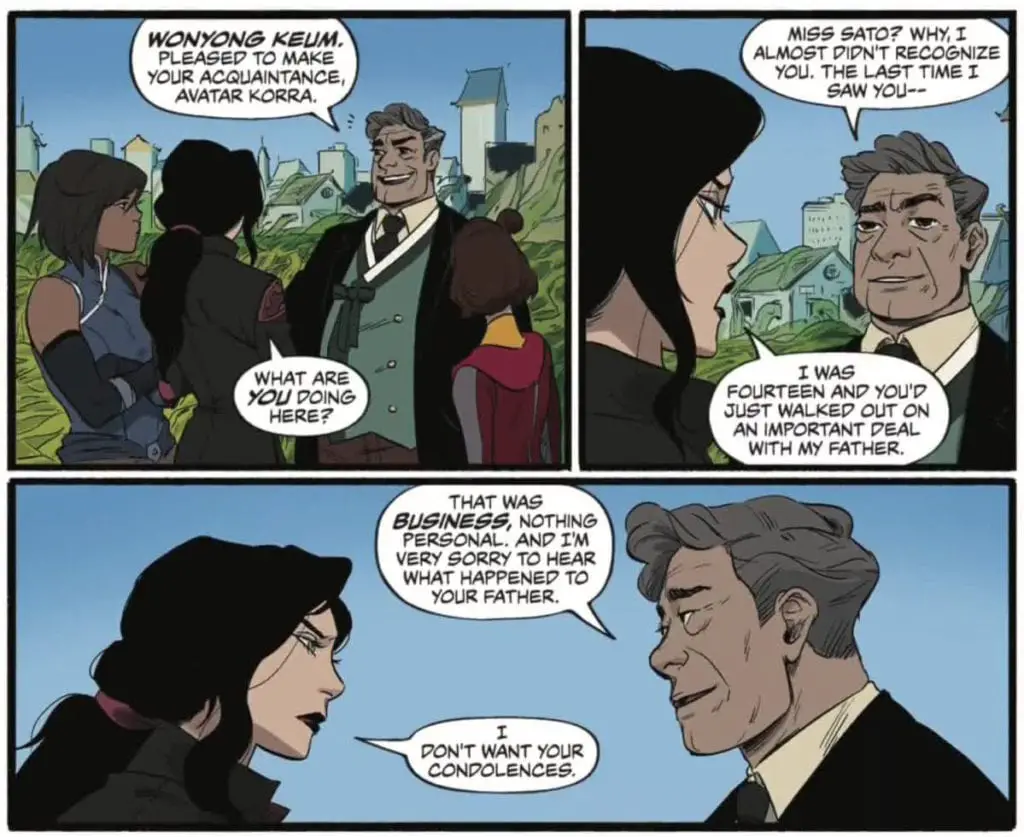
Also, there were moments that were genuinely funny. The car scene after Bolin and Mako make an arrest particularly stood out to us, along with a few reaction shots here and there.
“That’s just shoddy workmanship.”
We know we’ve sounded very negative throughout this review, and because we have such strong feelings about the Avatar-verse, we planned for this possibility with a Book Report Rubric, so we can give it an objective score.

Let’s go through it, shall we?
Canon Compliancy

We really hate to say it, but…what is this, some kind of modern AU? Look, we know this is a ridiculously harsh score and we don’t want to leave it as self-evident, but remember that piece we promised in a on Friday? Yeah, it covers every inch of this. (And more!) You’ll have to trust us when we say this isn’t a snap-judgement.

In fairness, there were certain threads in continuity, such as the evacuation still having been a thing, but the entire premise of these comics render those details moot.
Logic

Okay, so we had this at a “3” when we outlined this review. Then we kept thinking. And thinking. And thinking… No seriously, what is anyone doing?
Why is Raiko, who is so concerned about reelection (against nobody), holed up in an office instead of dealing with the ONE CRISIS THAT EXISTS? Why are the Republic City Cops so focused on gang-on-gang violence (which is always the lowest priority on the totem pole for literally every police force in every city) when there’s a sizable number of citizens without basic needs being met. The police have airships and are comprised of many expert earth and metalbenders: they could be repairing everything. You know…the ONE CRISIS THAT EXISTS. What was anyone doing for three weeks? Asami was seriously the first person to suggest drawing housings plans to deal with the ONE CRISIS THAT EXISTS? And don’t get us started on the landowner turning to gangs instead of the police or even Raiko about development on his property that he rightfully owns. Lin would have been all over this.
This doesn’t even touch Asami almost-magically-dying despite us seeing her totally fine the panel beforehand, how Korra and Asami were framed as stepping into the Southern Portal and immediately warping to Republic City, or some odd timeline-continuity stuff with the concept of day and night. We realize a lot of these are nitpicks, but there are just so many that they add up to paint a picture of complete sloppiness.
The most “logical” aspect is Korra and Asami navigating being closeted, but that relies on a setting that also doesn’t make sense with what we’ve seen before. So…yeah. Why didn’t Korra just talk to Tenzin first? Hell, does Tenzin even know that his daughter is leading a group of eco-terrorists? Does he care?
Consistency of Characters
So, we had a bit of a disagreement on this one. Griffin feels strongly about a “2”, while Kylie thinks a “3” is more appropriate. We’re settling on a 2.5.
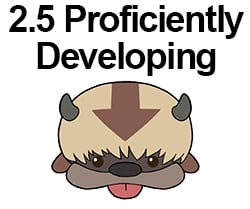
The thing is, the description of the “2” is eerily similar to what happened. Sure, Hiroshi got one mention, but there was nothing before or after that, and it certainly didn’t seem to be coloring Asami’s behavior. Do we have any reason to believe it affected her views on the spirit world land development? Bolin did happen to be scripted perfectly, and Kylie feels that pretty much every non-Korra character was fine (well…Asami may have been slightly buzzed and/or sleep deprived the entire time), even if Kya felt woefully out of place and random. However, punch-first Korra was simply disheartening to see, and not something we actually expected to happen. Some of this rubric was a wee bit tongue-in-cheek, if you couldn’t tell.
Artwork

Although we know some readers may have wanted exact replicas of Studio Mir’s character models, we’re quite happy that Bryke gave the artist the latitude to draw in her own style. Irene Koh’s softer images felt like a strong tonal fit for the comic. There were numerous inconsistencies in proportions, shape, continuity, shadowing, and perspective, and we would have preferred more background detail, though admittedly we’ve been immersed in Martinez’s run in Detective Comics where the man recreated the entire Vegas strip. Overall, nothing detracted from our immersion in the story, and the excellent lettering made everything quite easy to follow. We also want to give props to the superstar colorist for crafting the environment and really selling it as the Avatar universe. For us, this was a “3”, and we say that fully admitting that our “5” was a complete joke.
Unfortunate Implications

We’re a little alarmed, because we thought this would be an easy “5.” That’s why the bottom two are complete jokes (plus some well-deserved shade on North & South, as well as Marvel’s nazi-tastic Secret Empire). That said, we do know that our takeaways and the way we read this book doesn’t speak for anyone but us. We do feel that unsavory implications are there for those to see, and will certainly expand on it in the aforementioned piece that’s coming soon.
For instance, part of Sozin “spreading his culture” in ATLA now involves the imprisonment and likely torture (or murder) of gay individuals. For kids! On a Doylist level , we do hold adamant that “queer women will always have to fight for their right to exist” is not comfortable, or even an appropriate message, particularly for younger readers. But hey, at least the homophobes are shown to be in the wrong.
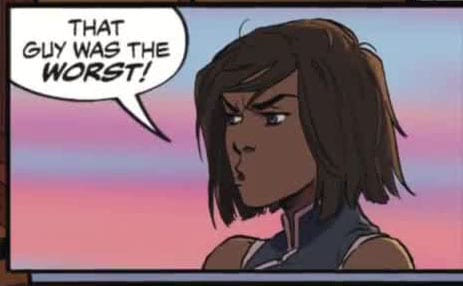
There’s a more minor implication that Korra’s relationship with Asami negatively affects her ability to be the Avatar, since it was when she had to “save” Asami from the triad members that Tokuga got corrupted by a spirit. We’re assuming this is going to have repercussions in Part 2, and we hate the idea that “Korra never needed to bail Mako out” is going to be part of fandom dialogue, especially when Asami seemed…totally fine? She’s quite good at closing the gap on her enemies normally, and we’re not sure why she was suddenly flopped over after a little water to the face. However, we also know at this point, anti-Korrasami rhetoric will be pulled from thin air (don’t forget Asami being described as “predatory” in the close of Book 3), so we don’t want to lend too much credence to this. There’s already plenty of other questionable implications to come from the overall narrative decisions and messaging.
Calculated Comic Grade: 46%, or 4/10
Frankly, we were going to take the easy road and explain that our rubric is weighted low (sort of, though the 1’s are jokes too), and add a few points so we could give this a 7 out of 10. We wanted to say that although Turf Wars is not our taste, it has strong positive messaging and opens up an interesting plotline within the Avatar-verse. But we can’t even convince ourselves of this. Especially when our subjective non-rubric score might not have even been this generous.
We know that the creative team’s hearts were in the right place, and we feel bad being so harsh for this reason. It’s just that…simply put: we’re both frustrated and offended. We view this story as nothing but contemporary, western mores slopped onto a setting where they don’t fit, causing the characters we once saw celebrated on our screens to be turned into individuals hesitant to live honestly, which serves no purpose other than to remind us that homophobia is bad. Even assuming systemic prejudice is defeated in the end, what was the point? What makes this story actually worth telling?
We suspect many readers have an answer to that question, and one that’s meaningful to them. We just wish we could get there ourselves.
Editor’s note (7/28/2017, 5:00 PST): The follow-up piece is available HERE.
(7/26/2017, 8:53 PST): The wording of the ending of this review has been changed to emphasize the intent of the piece—the reviewers’ subjective reactions against what it likely a meaningful and uplifting story for many. This review is in no way meant to shame or invalidate anyone with different takeaways.
(7/26/2017, 10:01 PST): Another change has been made indicating that the follow-up piece to this review will be released on The Fandomentals on Friday, 7/28/2017.
LEGEND OF KORRA: TURF WARS PART 1
Writer: Michael Dante DiMartino
Pencils/Inks: Irene Koh
Colors: Vivian Ng
Letterers: Nate Piekos and Blambot
Images Courtesy of Dark Horse and Viacom

